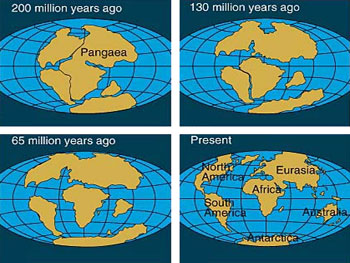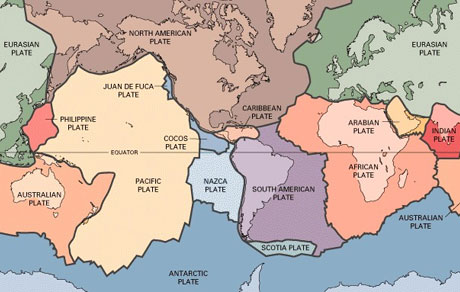Continental Drift
What is a continental drift?

Soon after the Earth formed billions of years ago, the Earth's rocky outer crust solidified. This crust is not a solid shell; it is broken up into huge, thick plates that drift atop the soft, underlying mantle.
The plates are made of rock and drift all over the globe hence called a continental drift. They move both horizontally and vertically. Over long periods of time, the plates also change in size as their margins are added to, crushed together, or pushed back into the Earth's mantle. It is the heat generated by radioactive decay inside the Earth which drives this process. These plates are from 80 to 400 km (50 to 250 miles) thick.
At some stage in history a process called continental drift began. We do not know when because the rocks have been squashed and changed so much since then, but it is important because it is still happening today. Some people think that it caused the Ice Ages.
Theory of plate tectonics

The theory of plate tectonics, which includes continental drift, forms a framework for the study of geology and the Earth.
The theory proposes that the Earth's crust is broken up into eight major and and about twenty smaller tectonic plates that move over the surface of the Earth. These tectonic plates are massive, irregularly shaped slabs of solid rock.
It is believed that hot rock rose up from the mantle and spread out on the surface of the Earth to form the ocean floor. As the ocean floor spread it pushed the continents around. Even today, the continents are moving one or two centimeters each year.
As the continents move around they sometimes hit each other, creating mountains. This is how the Alps and the Himalayas were created. Mountains like this are on the inside of continents.
Sometimes continents do not hit head on, but rub past each other. Since they do not have smooth edges, the rubbing is jerky and uneven. Pressure builds up and is then suddenly released. This creates Earthquakes. The San Andreas fault in California is an example of this.
In some places the floor sinks back down into the mantle, usually at the edge of a continent. As it sinks it melts and hot rock rises up, creating volcanoes along the coast. The Andes are being created in this way. Sometimes the volcanoes lie in an arc just off the coast of a continent. The islands of Japan are being formed like this.